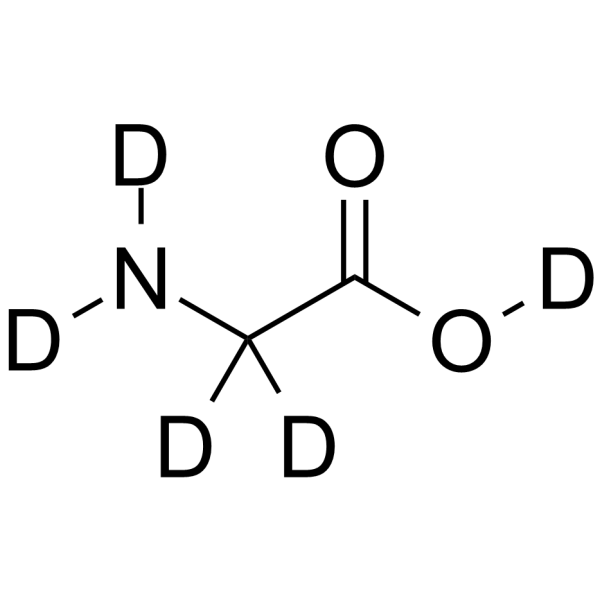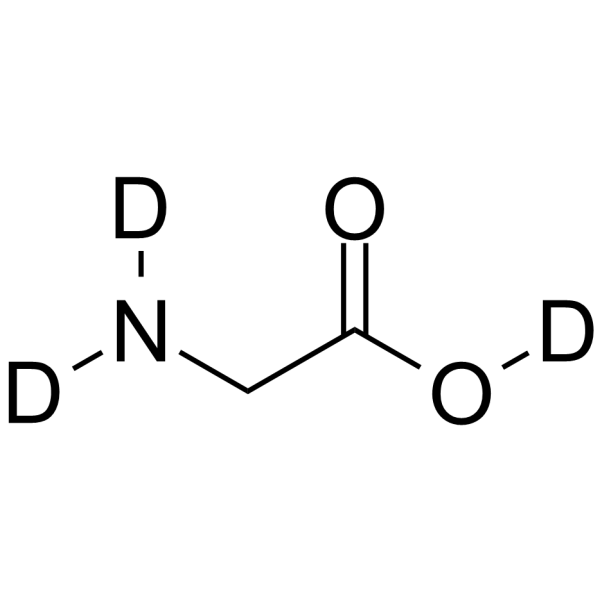4896-77-9
| 中文名 | 甘氨酸-d5 |
|---|---|
| 英文名 | deuterio 2,2-dideuterio-2-(dideuterioamino)acetate |
| 英文别名 |
Aciport-d5
Glycosthene-d5 perdeuterioglycine 2,2,O-trideuterio-2-dideuterioamino-acetic acid Glicoamin-d5 (H)Glycine Glycine-d5 pentadeuterio-glycine Pentadeuterio-glycin Padil-d5 Glycocoll-d5 Aminoacetic Acid-d5 Glycolixir-d5 Glycine-d MFCD00064427 Gyn-Hydralin-d5 EINECS 225-518-6 |
| 描述 | 甘氨酸-d5是氘标记的甘氨酸。甘氨酸是中枢神经系统中的一种抑制性神经递质,也与谷氨酸一起作为共同激动剂,促进谷氨酰胺能N-甲基-D-天冬氨酸(NMDA)受体的兴奋电位。 |
|---|---|
| 相关类别 | |
| 体外研究 | 氢、碳和其他元素的稳定重同位素已被纳入药物分子中,主要作为药物开发过程中定量的示踪剂。氘化因其可能影响药物的药代动力学和代谢特征而受到关注[1]。 |
| 参考文献 |
| 密度 | 1.3±0.1 g/cm3 |
|---|---|
| 沸点 | 240.9±23.0 °C at 760 mmHg |
| 熔点 | 240ºC (dec.)(lit.) |
| 分子式 | C2D5NO2 |
| 分子量 | 80.097 |
| 闪点 | 99.5±22.6 °C |
| 精确质量 | 80.063416 |
| PSA | 63.32000 |
| LogP | -1.03 |
| 外观性状 | 白色粉末 |
| 蒸汽压 | 0.0±1.0 mmHg at 25°C |
| 折射率 | 1.461 |
| 储存条件 | 密封储存,储存于阴凉、干燥的库房。常用氮气保护。 |
| 稳定性 | 常温常压下稳定,避免与不相容材料,热源,湿空气,水接触。 与强氧化剂反应。 |
| 计算化学 | 1、 疏水参数计算参考值(XlogP):-1.8 2、 氢键供体数量:2 3、 氢键受体数量:2 4、 可旋转化学键数量:1 5、 互变异构体数量:2 6、 拓扑分子极性表面积(TPSA):69.1 7、 重原子数量:5 8、 表面电荷:0 9、 复杂度:42.9 10、 同位素原子数量:6 11、 确定原子立构中心数量:0 12、 不确定原子立构中心数量:0 13、 确定化学键立构中心数量:0 14、 不确定化学键立构中心数量:0 15、 共价键单元数量:1 |
| 更多 | 1. 性状:白色粉末 2. 密度(g/mL,25℃):未确定 3. 相对蒸汽密度(g/mL,空气=1):未确定 4. 熔点(ºC):240 5. 沸点(ºC,常压):未确定 6. 沸点(ºC,0.375mmHg):未确定 7. 折射率(n20/D):未确定 8. 闪点(ºF):未确定 9. 比旋光度(º):未确定 10. 自燃点或引燃温度(ºC):未确定 11. 蒸气压(mPa,20ºC):未确定 12. 饱和蒸气压(kPa,25ºC):未确定 13. 燃烧热(KJ/mol):未确定 14. 临界温度(ºC):未确定 15. 临界压力(KPa):未确定 16. 油水(辛醇/水)分配系数的对数值:未确定 17. 爆炸上限(%,V/V):未确定 18. 爆炸下限(%,V/V):未确定 19. 溶解性:未确定 |
Synonym:None Section 2 - COMPOSITION, INFORMATION ON INGREDIENTS
Risk Phrases: None Listed. Section 3 - HAZARDS IDENTIFICATION EMERGENCY OVERVIEW
The toxicological properties of this material have not been fully investigated.Hygroscopic (absorbs moisture from the air). Potential Health Effects Eye: Contact may cause transient eye irritation. The toxicological properties of this material have not been fully investigated. Skin: May cause skin irritation. Low hazard for usual industrial handling. The toxicological properties of this material have not been fully investigated. Ingestion: Ingestion of large amounts may cause gastrointestinal irritation. Low hazard for usual industrial handling. The toxicological properties of this substance have not been fully investigated. Inhalation: May cause respiratory tract irritation. Low hazard for usual industrial handling. The toxicological properties of this substance have not been fully investigated. Chronic: No information found. Section 4 - FIRST AID MEASURES Eyes: Flush eyes with plenty of water for at least 15 minutes, occasionally lifting the upper and lower eyelids. Get medical aid. Skin: Flush skin with plenty of water for at least 15 minutes while removing contaminated clothing and shoes. Get medical aid if irritation develops or persists. Wash clothing before reuse. Ingestion: Never give anything by mouth to an unconscious person. Do NOT induce vomiting. If conscious and alert, rinse mouth and drink 2-4 cupfuls of milk or water. Get medical aid if irritation or symptoms occur. Inhalation: Remove from exposure and move to fresh air immediately. If not breathing, give artificial respiration. If breathing is difficult, give oxygen. Get medical aid. Notes to Physician: Section 5 - FIRE FIGHTING MEASURES General Information: As in any fire, wear a self-contained breathing apparatus in pressure-demand, MSHA/NIOSH (approved or equivalent), and full protective gear. During a fire, irritating and highly toxic gases may be generated by thermal decomposition or combustion. Extinguishing Media: Use agent most appropriate to extinguish fire. Do NOT get water inside containers. Use water spray, dry chemical, carbon dioxide, or appropriate foam. Section 6 - ACCIDENTAL RELEASE MEASURES General Information: Use proper personal protective equipment as indicated in Section 8. Spills/Leaks: Vacuum or sweep up material and place into a suitable disposal container. Clean up spills immediately, observing precautions in the Protective Equipment section. Avoid generating dusty conditions. Provide ventilation. Do not get water inside containers. Section 7 - HANDLING and STORAGE Handling: Wash thoroughly after handling. Use with adequate ventilation. Minimize dust generation and accumulation. Avoid breathing dust, vapor, mist, or gas. Avoid contact with eyes, skin, and clothing. Keep container tightly closed. Avoid ingestion and inhalation. Do not allow contact with water. Keep from contact with moist air and steam. Storage: Keep under a nitrogen blanket. Store in a cool, dry, well-ventilated area away from incompatible substances. Store protected from moisture. Section 8 - EXPOSURE CONTROLS, PERSONAL PROTECTION Engineering Controls: Facilities storing or utilizing this material should be equipped with an eyewash facility and a safety shower. Use adequate ventilation to keep airborne concentrations low. Exposure Limits CAS# 4896-77-9: Personal Protective Equipment Eyes: Wear appropriate protective eyeglasses or chemical safety goggles as described by OSHA's eye and face protection regulations in 29 CFR 1910.133 or European Standard EN166. Skin: Wear appropriate protective gloves to prevent skin exposure. Clothing: Wear appropriate protective clothing to prevent skin exposure. Respirators: Follow the OSHA respirator regulations found in 29 CFR 1910.134 or European Standard EN 149. Use a NIOSH/MSHA or European Standard EN 149 approved respirator if exposure limits are exceeded or if irritation or other symptoms are experienced. Section 9 - PHYSICAL AND CHEMICAL PROPERTIES Physical State: Crystalline powder Color: brown - white Odor: Not available. pH: Not available. Vapor Pressure: Not available. Viscosity: Not available. Boiling Point: Decomposes Freezing/Melting Point: 248 deg C dec Autoignition Temperature: Not available. Flash Point: Not available. Explosion Limits, lower: Not available. Explosion Limits, upper: Not available. Decomposition Temperature: > 248 deg C Solubility in water: Specific Gravity/Density: Molecular Formula: C2D5NO2 Molecular Weight: 80.11 Section 10 - STABILITY AND REACTIVITY Chemical Stability: Stable under normal temperatures and pressures. Conditions to Avoid: Incompatible materials, dust generation, moisture, excess heat, exposure to moist air or water. Incompatibilities with Other Materials: Oxidizing agents. Hazardous Decomposition Products: Nitrogen oxides, carbon monoxide, irritating and toxic fumes and gases, carbon dioxide. Hazardous Polymerization: Has not been reported Section 11 - TOXICOLOGICAL INFORMATION RTECS#: CAS# 4896-77-9 unlisted. LD50/LC50: Not available. Carcinogenicity: Glycine-D5 - Not listed by ACGIH, IARC, or NTP. Section 12 - ECOLOGICAL INFORMATION Section 13 - DISPOSAL CONSIDERATIONS Dispose of in a manner consistent with federal, state, and local regulations. Section 14 - TRANSPORT INFORMATION IATA Not regulated as a hazardous material. IMO Not regulated as a hazardous material. RID/ADR Not regulated as a hazardous material. Section 15 - REGULATORY INFORMATION European/International Regulations European Labeling in Accordance with EC Directives Hazard Symbols: Not available. Risk Phrases: Safety Phrases: S 24/25 Avoid contact with skin and eyes. S 28A After contact with skin, wash immediately with plenty of water. S 37 Wear suitable gloves. S 45 In case of accident or if you feel unwell, seek medical advice immediately (show the label where possible). WGK (Water Danger/Protection) CAS# 4896-77-9: No information available. Canada None of the chemicals in this product are listed on the DSL/NDSL list. CAS# 4896-77-9 is not listed on Canada's Ingredient Disclosure List. US FEDERAL TSCA CAS# 4896-77-9 is not listed on the TSCA inventory. It is for research and development use only. SECTION 16 - ADDITIONAL INFORMATION N/A |
| 安全声明 (欧洲) | S24/25 |
|---|---|
| 危险品运输编码 | NONH for all modes of transport |
|
~% 
4896-77-9 |
| 文献:Mueller, Carmen; Schajor, W.; Zimmermann, H.; Haeberlen, U. Journal of Magnetic Resonance (1969-1992), 1984 , vol. 56, # 2 p. 235 - 246 |
| 上游产品 1 | |
|---|---|
| 下游产品 4 | |



![Propanamide,N-[(1S,2R,3E,5E,7S,9E,11E,13S,15R,19R)-7,13-dihydroxy-1,4,10,19-tetramethyl-17,18-dioxo-16-oxabicyclo[13.2.2]nonadeca-3,5,9,11-tetraen-2-yl]-2-oxo-结构式](https://image.chemsrc.com/caspic/138/23623-31-6.png)


